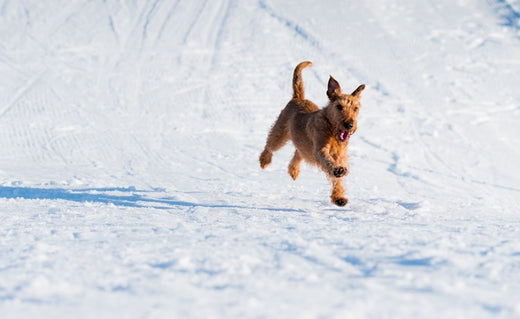
Beat the Winter Blues: Seasonal Mood Changes in Dogs During the Winter
Table of Contents
- Introduction
- Do dogs get the winter blues?
- Causes of the winter blues in dogs
- Potential Mood Changes in Dogs to Look Out For
- How to Help
- Owner’s Self-Care Matters Too!
- Conclusion
Beat the Winter Blues: Seasonal Mood Changes in Dogs During the Winter
Throughout the spring, summer and fall, your dog is active and lively, eager to play and be by your side. But when winter comes, your rambunctious pooch suddenly seems to be sleeping more, nervous or disinterested in the toys and games that usually get them up and moving.
If this sounds familiar, you're not alone. Many dog parents notice that their fur babies' moods and behaviors seem to shift during the winter months. This leads to a simple question: do dogs develop the winter blues like some people do? In this post, we'll explore the answer and share tips on what you can do to help your pet during the cold weather season.
Can Dogs Handle Cold Weather?
Before we get into how winter can affect a dog's mood and behavior, let's take a step back and examine another key question that many pet owners have: can dogs be in the cold weather safely?
The answer is that how much cold a dog can tolerate varies. Dogs with long hair and thick coats may be able to enjoy time outdoors comfortably on cold days, but ones with shorter hair may get cold very quickly and have less tolerance for winter weather. Because their bodies are closer to the cold ground, dogs with short legs also tend to be more cold-sensitive, and elderly dogs and those with arthritis may find it more difficult to walk in snowy and icy conditions.
That's why the American Veterinary Medical Association recommends that owners keep all dogs indoors as much as possible during the winter and suggests that you consult your veterinarian for personalized advice regarding the ideal amount of outdoor time for your pet.
Do Dogs Get the Winter Blues?
When people talk about their winter blues, they're usually referring to seasonal affective disorder or SAD. A form of depression, SAD occurs when reductions in daylight during the winter disrupt the circadian rhythms that control the sleep-wake cycle, leading to changes in brain chemical levels.
From a biological standpoint, dogs don't develop SAD the way that people do, so they don't technically develop the winter blues. However, winter can still impact dogs and lead to changes in their moods and behaviors.
Causes of the Winter Blues in Dogs
If seasonal affective disorder isn't the reason why dogs seem blue during the winter months, what is the cause? The answer is that it depends on the dog. A number of things can lead to changes in your pup in cold weather, such as all of the following.
Changes in Routine
Dogs are creatures of habit and take comfort in a repetitive daily schedule. Winter often leads to deviations from regular routines. For example, you may be walking your dog in cold weather for shorter periods of time, or they may not be free to explore the backyard for as long when they head outside to go to the bathroom. The disruptions in their usual schedule can leave dogs feeling anxious or depressed.
Shorter Days
Just as the human body must adapt to shorter days due to Daylight Savings Time, dogs must also adjust to longer periods of darkness. In some cases, the fact that it gets darker earlier and the sun rises later leads to shifts in dogs' sleeping patterns, and you may notice your dog seeming sleepier during the day.
Sensitivity to Human Behavior
Dogs are very in tune with their human caretakers' emotions and moods. When winter negatively affects their human parents, dogs may take notice and mirror that behavior.
Holiday Anxiety
Many dogs experience holiday anxiety due to various triggers like disruptions in routine, unfamiliar guests and decorations. While anxiety may subside shortly after the holidays come to an end, for some dogs, symptoms may linger for weeks or months afterward.
Fears and Phobias
Some dogs are naturally fearful of the snow and ice. For these pups, heading outdoors can be stressful. Some dogs may even become fearful of seeing snow accumulated on the windows or skylights in their homes.
Potential Mood Changes in Dogs to Look Out For
The first step toward helping your pet cope with the winter blues is recognizing symptoms that your dog may be feeling anxious, nervous or depressed. Some symptoms to look out for include:
- Changes in sleep patterns: Your dog may sleep for longer periods or sleep at different times during the day than usual.
- Boredom: Your dog may not be as excited to play or be less interested in exercise.
- Changes in eating: Your dog's appetite may decrease.
- Behavior changes: Your dog may exhibit symptoms of anxiety or nervousness like trembling, restlessness and hiding.
How to Help
To help your dog weather the winter blues and feel their best throughout the season, follow these tips:
- Keep up with regular walks:Although they may need to be shortened due to conditions, continuing with walking can help maintain your routine, fight boredom and keep your dog active. Ask your vet for tips on how to exercise your dog in the winter safely.
- Try some new indoor playtime activities:Introducing some fun winter dog activities can give your dog something to look forward to and potentially improve their mood. Some great indoor activities for dogs in winter include scent work, learning new tricks, food puzzles and homemade agility courses.
- Schedule play dates: Dogs may miss spending time at the dog park with other pooches, so give them a chance to socialize by inviting a furry friend over to play.
- Increase your snuggle time: Spending more quality time snuggling and being close to you can help to reassure a nervous dog.
- Give Kradle a try:Made with broad-spectrum CBD, our can help maintain contentment during separation that occurs during the winter months and potentially help your dog maintain a normal disposition during the winter months.
- Look after your own mental health: Your mood matters to your dog, so practice good self-care throughout the winter by eating a well-balanced diet, exercising regularly and discussing any symptoms of seasonal depression that you experience with your health care provider.
Beat the Winter Blues Together
Even though the underlying causes are different, dogs can experience their own form of the winter blues just like people do. The good news is that by taking some proactive steps, you can help your dog feel better and address problem behaviors that arise when cold weather arrives. Keep the above tips in mind as winter continues and make supporting mental health for you and your pooch a top priority throughout the season.







